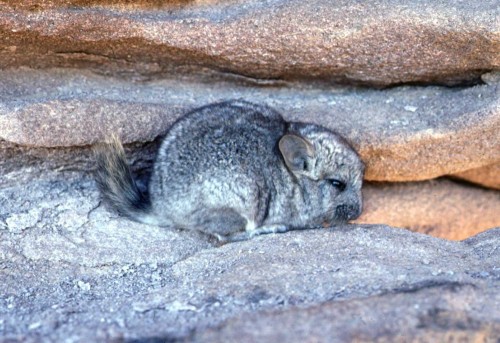Their former range included the Andes of southern Peru, Bolivia, northwestern Argentina and northern Chile, but today the Short-tailed Chinchilla (Chinchilla chinchilla) is known only from a handful of individuals captured in 2001, and more recently from camera trap records from 2011 in Nevado Tres Cruces National Park (Atacama region, northern Chile).
How this species is doing
Pressure
This species was driven to the brink of extinction by commercial exploitation, which began in 1828. The dense, silky fur of the short-tailed chinchilla is extremely valuable, and during the nineteenth century millions of chinchilla pelts were exported to the United States, France, England and Germany. As populations declined market prices soared, stimulating increased efforts to capture chinchillas. Both species of chinchilla were trapped, but this species was especially sought after because of its higher-quality fur and larger size. Although chinchillas are now protected by law in their natural habitat, enforcement is difficult in the remote areas involved and hunting continues. Populations may also have declined as a result of habitat destruction, particularly though the burning and harvesting of the algarrobilla shrub (Balsamocarpon brevifolium).
Responses
The species is on Appendix I of CITES, and has been protected by law in Chile since 1929. Recent improvements in the quality of captive chinchilla fur has reduced pressure on the remaining wild populations; however, several of the eleven wild short-tailed chinchillas captured in 2001 were transferred to a breeding programme in which they were used to boost the genetic diversity of the captive population. The US-based conservation organization “Save the Wild Chinchillas” is focusing on raising awareness of the two chinchilla species, promoting research, and conserving wild populations of the long-tailed chinchilla. Further surveys, especially using camera traps, are needed to establish the location of wild populations of this species.
Knowledge level
These chinchillas are found in relatively barren areas of the Andes mountains at elevations of 3,000 to 5,000 m. They shelter in crevices and holes among the rocks. Chinchillas are most active at dawn and dusk and during the night, although they have occasionally been observed outside of their holes on sunny days. They are thought to live in colonies ranging in size from a few individuals to more than a hundred. Their diet consists of any available vegetation. Lifespan is probably more than 10 years in the wild, although captive individuals have lived for more than 20 years.








